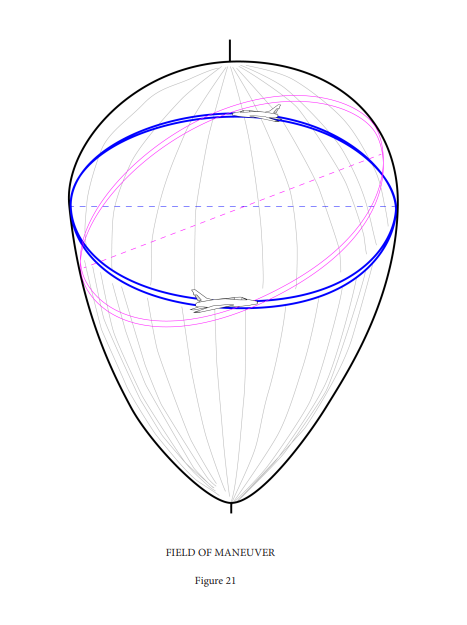Basic Limitations of AIM-9B against a Maneuvering Target -- Defensive Turn
Fighter Maneuvers
To acquire an understanding of the science of fighter-versus-fighter combat, a complete knowledge of the spatial relationships involved in this form of aerial combat, is necessary. Before he can achieve this understanding, any tactician must be able to define or imagine a frame of reference, within which he must operate. In addition, he must know the basic tools which he may employ in this frame of reference. Simply stated, this means that the pilot must understand the geometric space relationships and how to apply this insight to a given fighter-versus-fighter situation. Our purpose, in fighter maneuvers, will be two-fold: (1) To define and present geometric relationships needed for fighter-versus fighter combat, and (2) to show how to properly apply these relationships in fighter maneuvers.
In discussing fighter-versus-fighter combat, it is evident that many pilots believe there are an infinite number of situations and solutions in a given tactical encounter. Such is not the case! The field in which a fighter pilot must operate is three-dimensional and finite. The size and shape of the field is determined by the pull of 1G gravity and the performance limitations of the aircraft and its pilot. We can imagine this field to be spherical in shape, with a flattened northern hemisphere and an elongated southern hemisphere. See figure 21. The spherical shape is generated by a maneuvering fighter’s turn and velocity operating through three dimensions. The elongation results from the effect of 1G gravity on the fighter in this three-dimensional field of maneuver. Turn, speed and the force of gravity determine the operating envelopes and we need only understand spatial relationships presented by these factors to develop effective fighter maneuvers. To know how to secure an advantage over an opponent, an attacker need only visualize turn, velocity and G projected onto this spheroid shape. He has no control over the force of gravity, of course, but he can exercise complete control over aircraft turn and velocity. As a result, he can maneuver in a manner to effectively use the pull of gravity in a given tactical situation. Thus in a fighter-versus fighter situation, the pilot can do two things to gain an advantage over an opponent: Change turn and/or velocity, in respect to his opponent. He can accomplish either or both by maneuvering through both the vertical and horizontal planes by employing either a two-dimensional maneuver through three-dimensional space, or a three-dimensional maneuver (barrel roll).
To apply these principles correctly, we need only recall what we determined previously in regard to weapons capability. We determined that to successfully employ AIM-9B or the 20mm cannon, we must attain a launch or firing position in the angular velocity cone emanating from the tail of our opponent. Applying the three-dimensional concept of turn and velocity, this means that we must reduce one or both of these factors in order to secure an advantage. Employing these spatial relationships against a given opponent will provide insight as to the type of maneuver which we must employ to defeat him.
In our discussion of fighter maneuvers, we will keep in mind this concept of turn and velocity within a three-dimensional field. As stated earlier, we will use the case system to determine not only what maneuver to employ, but also how to employ it to acquire maximum benefit. In discussing fighter-versus-fighter tactics, our first maneuver for discussion will be the defensive turn. We choose to start with this maneuver because it is the basic maneuver by which the defender tries to nullify an attacker’s advantage. This may cause our approach to appear to be defensive in nature, however, we feel that this is necessary since any offensive action is directly dependent on the precise maneuver which the defendant chooses to execute. If the defender’s knowledge is limited in scope, the attacker’s corresponding maneuvers will reflect this limitation.
Basic Limitations of AIM-9B against a Maneuvering Target -- Defensive Turn
